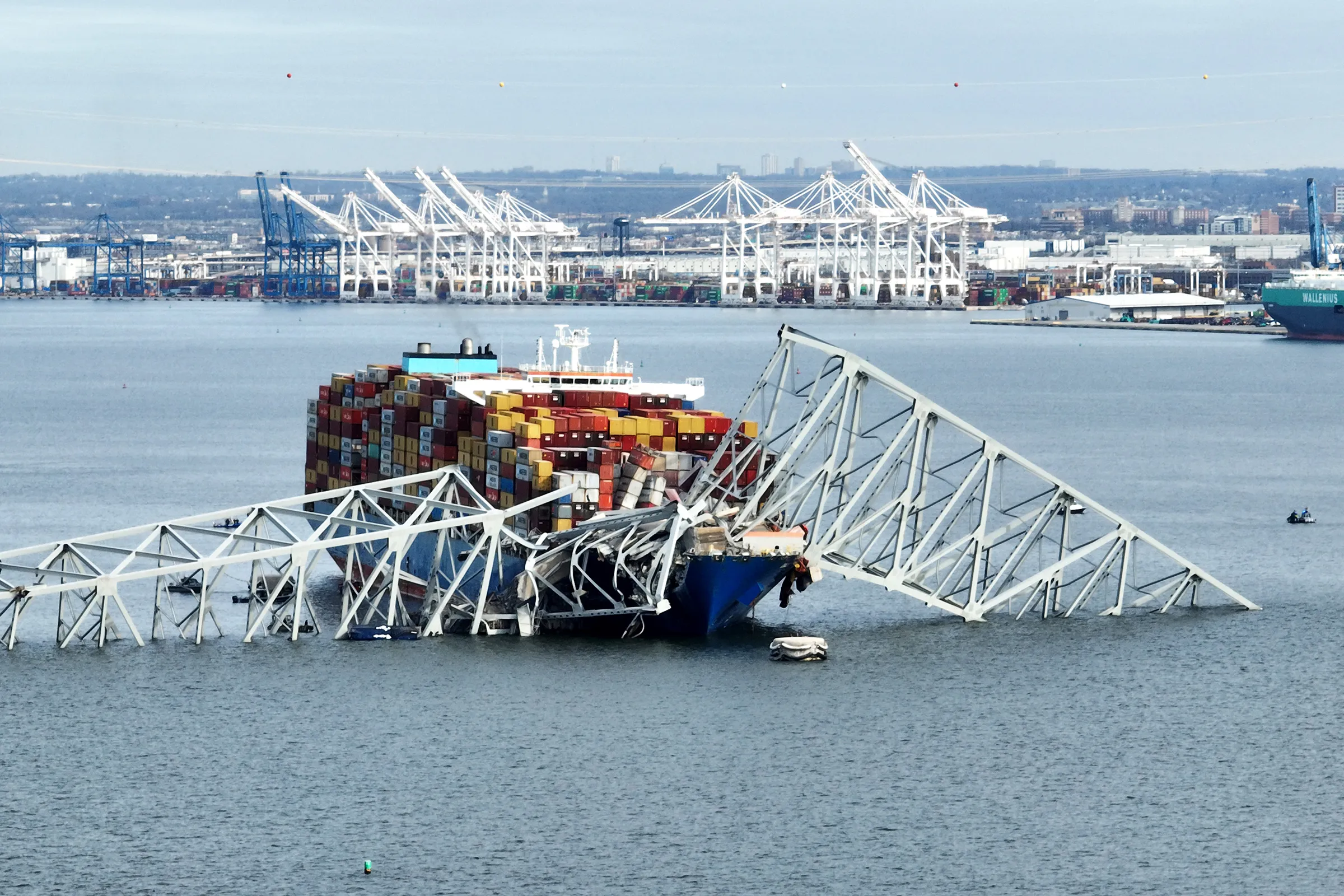A cargo ship collided with Baltimore’s Francis Scott Key Bridge early Tuesday, leading to the collapse of the span and the presumed deaths of six individuals. Here’s the current information available about the collapse:
The incident involving the collapse of the Francis Scott Key Bridge in Baltimore was triggered by a series of events that unfolded early Tuesday. The Dali cargo ship, operated by its crew, sent out a mayday call signaling a loss of power just moments before the collision occurred. Despite this distress call, the vessel continued its trajectory toward the bridge at an alarmingly rapid pace, as reported by Maryland Governor Wes Moore. With the ship measuring 985 feet in length, its impact on one of the bridge’s supports was substantial, leading to the collapse of a significant portion of the span within a matter of seconds.
Tragically, the collapse resulted in the presumed deaths of six construction workers who were present on the bridge at the time, engaged in routine maintenance tasks such as filling potholes. Investigations into the incident revealed that the Dali cargo ship had undergone recent inspections, both in Chile and by the U.S. Coast Guard, with no significant deficiencies reported prior to the collision.
The force of the collision, coupled with the immense weight of the vessel, caused the bridge support to buckle under the strain. Experts note that the 47-year-old bridge lacked adequate pier protection to withstand such a forceful impact.
Rescue efforts have managed to save two individuals, but six others remain missing and are feared to have lost their lives in the tragic incident. The collapse is expected to have far-reaching consequences, with logistical and economic disruptions anticipated in the region. The Port of Baltimore, a critical shipping hub on the East Coast, is likely to experience significant delays and interruptions in cargo traffic, affecting both commercial and commuter operations.
While the incident is not anticipated to have a substantial impact on global trade, it serves as a stark reminder of the importance of prioritizing safety measures and enhancing infrastructure resilience. Similar incidents of bridge collapses resulting from ship collisions have occurred in the past, underscoring the imperative to learn from such tragedies and implement measures to prevent their recurrence in the future.
Why the Baltimore Bridge Collapsed So Quickly?
Indeed, steel structures, while often perceived as robust, can be vulnerable to the immense force exerted by a container ship. The sheer power and weight of these vessels should not be underestimated.
The aftermath of the bridge collapse at a major US port has plunged the area into chaos, with several workers missing and a rescue operation underway. President Biden has labeled the incident a “terrible accident.” Ship traffic is halted on both sides of the crash site, and a key roadway in Baltimore has been severed.
David Knight, a bridge expert and specialist adviser to the UK’s Institution of Civil Engineers, describes the event as a “dreadful tragedy” and expresses a lack of surprise at the collapse’s manner based on footage he’s seen.
Knight highlights that while large steel structures may appear formidable, steel itself is relatively lightweight for its size. When subjected to sufficient force in the wrong direction, it can collapse like paper. In the case of the Francis Scott Key Bridge, it was a “continuous” or unjointed bridge with a 366-meter-long central truss section. Truss bridges utilize steel beams arranged in triangular shapes to support their load. The central truss comprised three horizontal stretches, or spans, with two sets of supports holding them above the water. Remarkably, it was the third-largest structure of its kind globally.
Knight emphasizes that the removal of a single support can lead to catastrophic consequences, as witnessed in the collapse of all three spans of the Francis Scott Key Bridge. While the approach spans remain intact, Knight sees no immediate evidence of structural issues with the bridge. Hardesty & Hanover, an engineering firm, confirmed conducting an inspection in 2019, and while subsequent inspections have occurred, further details on the bridge’s condition have not been provided.
The impact of the container ship shouldn’t be underestimated, Knight warns. Despite advancements in bridge engineering, heavy strikes can still cause significant damage. Contemporary bridges often incorporate defenses like hydraulic barriers and additional concrete around supports to mitigate potential damage from ship collisions.
The Dali, a Singapore-flagged ship built in 2015, experienced technical issues, indicated by the flickering lights observed before the crash. Salvatore Mercogliano, a maritime historian, highlights this as a significant problem. At the time of the accident, two pilots from Baltimore were on board, helping navigate the vessel. The ship’s broadcasted position via the automatic identification system (AIS) indicates it was traveling at over 8.5 knots before slowing to around 6 knots just before the crash.
The crew of the Dali made a mayday call to warn officials of the impending collision, with reports indicating a loss of propulsion and control. Governor Wes Moore credits this call with saving lives by allowing officials to halt traffic on the bridge. The ship’s sudden change in engine activity, visible in video footage, resulted in it veering off course and striking a key support of the bridge, though the exact reason for this deviation remains unknown.
Lawyer James Turner, specializing in ship collisions at Quadrant Chambers in London, explains that merchant ships like the Dali typically lack automated systems to prevent collisions. However, the crew would have access to radar, AIS, and visual observations to aid navigation.
Data-recording systems onboard commercial ships, similar to those found on airplanes, could provide crucial insights into the incident. These systems include audio recorders on the bridge, which preserve the last two hours of audio and data from various ship components such as the engine and steering. Turner notes that these recordings are highly reliable.
The ongoing priority for responders is locating survivors from the collapsed bridge. While two individuals have been rescued, with one hospitalized, six construction workers remain missing.
Source: https://www.yahoo.com/news/know-baltimore-bridge-collapse-170015740.html






